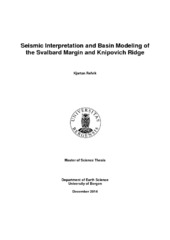Seismic Interpretation and Basin Modeling of the Svalbard Margin and Knipovich Ridge
Master thesis
Permanent lenke
https://hdl.handle.net/1956/9304Utgivelsesdato
2014-12-11Metadata
Vis full innførselSamlinger
- Department of Earth Science [1034]
Sammendrag
The Knipovich Ridge is a 550km long system situated on the seafloor west of Svalbard in the Northern Atlantic Ocean. It is a relatively young divergent boundary and ridge in the Northern Mid-Atlantic Ridge system. It is classified as an ultra-slow spreading ridge (Dick et al., 1993). In most cases the spreading direction at a divergent boundary is perpendicular to the ridge itself, but at the Knipovich ridge the direction is highly oblique. The bathymetry is also different from other ridge systems. Most ridges are symmetrical over a cross-section perpendicular to the rift axis, but the Knipovich ridge differs also on this point. The western part of the ridge has generally has a much higher relief compared to the eastern side of the rift basin. This could be related to the differences in sediment loading on each side of the ridge. Due to the large input of sediment during the last glacial periods, the sediment load is larger on the eastern flank of the ridge. The goal of this thesis is to interpret multi-channel seismic lines crossing the rift axis and subsequently model basement when the sedimentary units are back-stripped, in order to explore the possible correlation between sedimentary load and lack of symmetry. And, if no correlation is found, explore other solutions to the observations.
